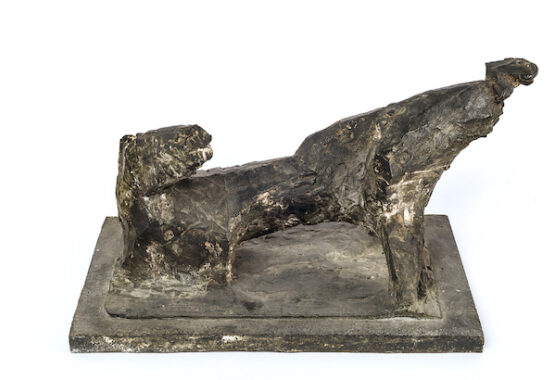Marino Marini's sculptures and paintings are dominated by depictions of horses. The artist has dedicated himself to a motif that, more than any other, is based on a long tradition in Western art history: starting with the iconic equestrian statue of Marcus Aurelius from the 2nd century to the "Gattamelata" by Donatello in Padua (1414) and the "Bartolomeo Corleoni". Century, to Donatello's "Gattamelata" in Padua (1453) and Verrochio's "Bartolomeo Corleoni" in Venice (1488), followed by Titian's depictions of Charles V (1548) and much later Jacques-Louis David's Napoleon, on horseback, crossing the Alps (1801).
But unlike these more politically motivated and melodramatic equestrian statues of the past, which were primarily intended to embody the untouchable power of the rulers depicted, Marini is not only interested in the primal and elemental power of the animals and their riders, but also in the transformation of this relationship, which for him also represents the state of humanity in general.
For Marini, horse and rider are a unity that stands at the beginning of human civilisation, acting as a symbolic embodiment. It is above all the Etruscans who fascinate Marini and who practised the breeding and taming of horses with intensity. For Marini, this represents the act of civilisation par excellence and he sees the connection between nature and man exemplified in the unity of horse and rider. A connection that over the centuries created the heroic myth of strength and invincibility. Industrialisation is gradually replacing the horse as man's natural companion, in all its facets, as a means of transport, as a workhorse or in the military, rendering it to the world of sport and luxury – while myth endures.
The inhumanity of the Second World War represents an artistic turning point for Marini: he recognises in it the entire drama of animal and man and of the whole of Western civilisation. Marini's riders and horses reflect this drama and de-heroise the myth, by mirroring the social changes that Marini experienced as a contemporary witness.
While Marini's early works still favour round and simple forms, later works become increasingly abstract and the round forms disappear in favour of expressive geometry or recede behind abstract ciphers. The self-evident unity of rider and horse is more and more dissolved; the rider can hardly hold himself on the horse's back and is sometimes thrown off completely:
"My horse's restlessness increases with each new work, the rider is more and more exhausted, he has lost his control over the animal, and the catastrophes to which he succumbs resemble those that destroyed Sodom and Pompeii. I strive to make visible the last stage of the destruction of a myth, the myth of heroic and victorious individualism, of the humanistic man of virtue. My work of the last years does not want to be heroic, but tragic." (Marino Marini 1972)
|
